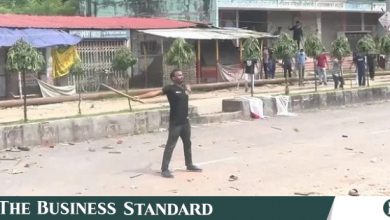The way HC verdict a headway for quota reform


Neither the agitators in 2018 nor the protesters now demanded a total abolishment of the quota. Rather, their demand was and is a reform
The anti-quota protesters blocked Shahbagh intersection today (11 July) as part of their “Bangla Blockade” programme demanding the reformation of quotas in government jobs. Photo: Mehedi Hasan/TBS
“>
The anti-quota protesters blocked Shahbagh intersection today (11 July) as part of their “Bangla Blockade” programme demanding the reformation of quotas in government jobs. Photo: Mehedi Hasan/TBS
Do the protesting students want total abolishment of quota? No. Did the High Court restore all the 56% quota as it had been before it was abolished following a movement in 2018? No.
The two ‘no’s mean a big ‘yes’ for all the relevant parties, particularly for the government and the agitating students.
A fresh round of agitation began from the beginning of this month following a High Court verdict on 5 June restoring quota in first and second classes government jobs.
It was neither clear to the agitators nor to anyone else that what the quota restoration by the High Court means.
Now all know all about it.
The 5 June’s short order of the High Court made public today (11 July) has two key points:
1. That the quota for children/grandchildren of valiant freedom fighters be restored and the quota reserved for districts, women, those with disabilities, tribes, minor races and others be maintained.
2. This judgment will not create any bar upon the respondents [government] if they change, reduce or increase the ratio or percentage of the quotas relating to the aforesaid criteria as and when necessary.
The HC also said: “The respondents [government] are at liberty to fill up the vacant post from the general merit list if any quota is not fulfilled in any public examination,
So, it means:
1. Quota is restored.
2. Government is in full liberty to determine the percentage of quota.
3. If any quota is unfulfilled, vacant posts will be filled up from the merit list.
Neither the agitators in 2018 nor the protesters now demanded a total abolishment of the quota. Rather, their demand was and is a reform.
Legal analysts said the High Court’s verdict, in fact, asked the government for that reform.
“The short order is clear on policy guideline, hopefully the full judgement will elaborate on the reform, no matter what we call it,” said an expert.
Before the quota was abolished in 2018 following a massive movement, 30% quota was allocated for valiant freedom fighters’ children and grand-children, 10% for women, 10% for districts lagging behind in government jobs, 5% tribes and minor races, and 1% for those with disabilities.
Altogether there was a 56% quota and protesting students want its rationalising, not cancellation. Their indication is altogether a 10-15% quota.
And, since they started agitation, they were saying that their demand is to the government, not to the court.
However, finally the way out came from the judiciary.
Now the Appellate Division will have a hearing on 7 August before which the full judgement from the High Court is expected to be made public.




